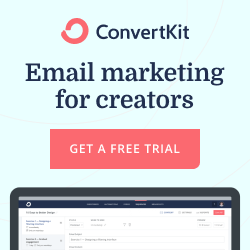In today’s digital age, building an email list is crucial for any business or creator looking to connect with their audience and nurture long-term relationships. But managing those emails manually can quickly become overwhelming. That’s where email marketing automation platforms like ConvertKit come in. This Beginner’s Guide to ConvertKit will equip you with the essential knowledge to start with this powerful tool and unlock the potential of email marketing automation.
What is ConvertKit?
ConvertKit is a popular email marketing platform specifically designed for creators and businesses focused on building online communities. Unlike some general email marketing platforms, ConvertKit prioritizes features that cater to content creators, bloggers, and course sellers.
Here are some of the key features that make ConvertKit a great choice for beginners:
- Focus on Creators: The platform offers features specifically tailored to creators, like landing page builders and integrations with popular course platforms.
- Subscriber Tags and Segments: Easily organize your audience based on interests and actions, allowing for targeted email campaigns.
- Email Sequences: Automate nurture sequences to deliver targeted content to new subscribers at predefined intervals.
- Visual Automations: Build drag-and-drop workflows to automate complex email marketing tasks based on subscriber behavior.
- Free Plan: A generous free plan allows you to build your email list and explore the platform’s core features before upgrading.
Getting Started with ConvertKit
Signing up for ConvertKit is a breeze. Simply head over to their website and create a free account. Once you’re in, you’ll be greeted by a user-friendly interface that’s easy to navigate, even for beginners with no prior email marketing experience.
Here are the initial steps to get you started with ConvertKit:
- Create Your Account: Sign up for a free ConvertKit account and explore the platform’s interface.
- Set Up Your Sender Information: This ensures your emails land in inboxes and avoid spam filters.
- Import Existing Subscribers (Optional): If you already have an email list, you can easily import them into ConvertKit.
- Design Your Opt-in Forms: Create eye-catching opt-in forms to collect email addresses from your website or blog.
Building Your Email List with ConvertKit
The heart of email marketing lies in building a targeted email list. ConvertKit provides powerful tools to help you capture leads and grow your audience:
- Landing Page Builder: Design high-converting landing pages with built-in forms to capture email addresses in exchange for valuable content like ebooks, webinars, or cheat sheets.
- Subscription Widgets: Create attractive signup forms to embed on your website or blog, allowing visitors to subscribe to your email list with ease.
- Lead Magnet Integrations: Connect ConvertKit with popular lead magnet delivery platforms to streamline the signup process and deliver valuable content automatically.
The Power of Email Marketing Automation
One of the biggest advantages of using ConvertKit is its built-in automation capabilities. This allows you to create automated email sequences that nurture new subscribers and deliver targeted content based on their interests and actions.
Here are some of the ways you can leverage ConvertKit’s automation features:
- Welcome Sequences: Automatically send a series of emails to new subscribers, introducing your brand, showcasing your value proposition, and building trust.
- Content Drip Campaigns: Deliver valuable content like blog posts, tutorials, or video lessons in a scheduled sequence, keeping your audience engaged with your brand.
- Segmentation-Based Automations: Create targeted email sequences based on subscriber tags and segments to deliver highly relevant content that resonates with specific audience interests.
Beyond the Basics: Advanced Features in ConvertKit
As you become comfortable with ConvertKit’s core functionalities. You can explore its advanced features to further enhance your email marketing efforts:
- A/B Testing: Test different subject lines, email content, and send times to optimize your campaigns for better performance.
- Automation Rules: Create complex workflows with conditional triggers and actions to deliver highly personalized email experiences.
- Ecommerce Integrations: Connect ConvertKit with your online store to send targeted emails based on purchase history or abandoned carts.
Conclusion
This Beginner’s Guide to ConvertKit has equipped you with the foundational knowledge to get started with email marketing automation. Remember, building a successful email list takes time and effort. By consistently providing valuable content, segmenting your audience, and leveraging ConvertKit’s powerful automation features, you can nurture long-term relationships with your subscribers and convert them into loyal customers or fans.
Ready to take the next step? Sign up for your free ConvertKit account today and explore the vast potential of email marketing automation! Join now [https://convertkit.com?lmref=f5r7Ig]


